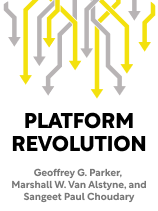

This article is an excerpt from the Shortform book guide to "Platform Revolution" by Geoffrey G. Parker, Marshall W. Van Alstyne, and Sangeet Paul Choudary. Shortform has the world's best summaries and analyses of books you should be reading.
Like this article? Sign up for a free trial here.
What makes businesses like Amazon and Spotify successful? How can you start your own platform?
In Platform Revolution, the authors compare the platform business model to the traditional business model known as a pipeline. They also outline the essential design and management strategies for platform developers.
Read below for a brief Platform Revolution book overview.
What’s Platform Revolution About?
Have you ever wondered what makes platform businesses like X (formerly known as Twitter), Spotify, and Amazon so successful? In the Platform Revolution book (2016), economists Geoffrey G. Parker and Marshall W. Van Alstyne and businessman Sangeet Paul Choudary provide the answer: Platform businesses leverage their novel characteristics to become uniquely competitive and transformative, with far-reaching effects on the economy, society, and politics. The authors also explain that running a platform business requires a distinct skill set—so in case you want to start your own platform business, they provide design and management tips to help you achieve success.
Parker and Van Alstyne are prolific and widely-celebrated researchers who received the 2019 Thinkers50 Digital Thinking Award for their pioneering research on platform businesses and digital economics. Choudary now applies his platform expertise as a business consultant and has published additional books on the topic, including Platform Scale for a Post-Pandemic World.
The Platform: A Novel Business Model
According to the authors, platforms emerged at the turn of the 21st century as a novel business model that connects producers with consumers. In this section, we’ll describe pipelines—the business model that dominated before platforms came about—and explain how platforms differ from pipelines, focusing on three unique characteristics: their leverage of network effects, their outsourcing of operations, and their ability to optimize connections.
Pipelines Preceded Platforms
Before we dive into the platform business model, let’s discuss the traditional business model that came before it, which Parker, Van Alstyne, and Choudary refer to as a “pipeline.” In a pipeline business model, a series of producers connect with each other to create a product that ends up in the hands of the consumer. To illustrate, think about how a wool sweater is made and sold—a shearer harvests wool from sheep, a processor turns that wool into yarn, a manufacturer turns that yarn into a knit sweater, and a retailer sells it to a consumer. The authors explain that for hundreds of years, most businesses relied on pipelines to create and sell their products, so pipelines became the default business model.
In contrast, platforms are businesses that facilitate direct connections between users (producers and consumers) for their mutual benefit. A farmer’s market, for example, is a platform because producers and consumers can cut out the middlemen (like grocery retailers) and do business together. The authors explain that around the turn of the 21st century, platforms became dramatically more popular because the technology boom created more opportunities for producers and consumers to interact. For example, eBay was founded in 1995 as an online marketplace where consumers could buy directly from producers instead of going to a pipeline-based retail outlet. Digital platforms like eBay are the focus of this book.
Platforms’ Unique Characteristics
Parker, Van Alstyne, and Choudary state that in addition to facilitating direct producer-consumer connections, platforms differ from pipelines in three important ways. Let’s explore those differences now.
Platforms Leverage Network Effects
According to the authors, platforms owe their success to their ability to leverage an economic phenomenon known as “network effects,” where the number of people involved in a market affects the market’s value. To illustrate, compare the social media platforms BeReal and Instagram—BeReal is less valuable than Instagram because fewer people use it. Due to the low quantity of users, there are fewer opportunities for engagement and interaction—the whole point of social media—compared to Instagram.
Network effects can be positive or negative for producers and consumers. For example, if you’re a handyperson on the labor platform TaskRabbit and more handypeople join, you might receive fewer requests for your services. This may benefit you if you receive fewer requests for jobs you lack enthusiasm or know-how for, or it may harm you by decreasing your earnings. An increase in the number of handypeople may also affect the platform’s value to consumers—for example, with more people, a consumer may be more or less likely to find the labor they need, depending on whether the new handypeople have the skills they’re looking for. Parker, Van Alstyne, and Choudary explain that successful platforms account for all of these variables and leverage network effects to maximize benefits for as many users as possible.
Platforms Outsource Operations
Another factor that contributes to platforms’ success is their ability to outsource operations. In pipeline businesses, the business must own or lease the resources needed to create and sell its product to consumers, which is expensive. For example, to sell a wool sweater, a retailer has to buy it from the manufacturer and buy or lease space to store and sell the product. In contrast, platforms outsource operating costs and procedures to the suppliers in their network. For example, instead of buying and paying to store inventory, the secondhand marketplace Poshmark outsources those responsibilities to individual sellers. Parker, Van Alstyne, and Choudary explain that outsourcing makes platforms cheaper to maintain and, therefore, easier to grow.
Platforms Optimize Connections
Finally, Parker, Van Alstyne, and Choudary state that platforms are successful because their design enables them to optimize producer-consumer connections. This occurs in two ways: First, by outsourcing operations, platforms remove barriers to participation. (For example, journalists don’t need to be formally hired by newspapers if they can freely access publishing platforms.) This introduces variety, spontaneity, and innovation into the market, which makes it more likely that consumers will connect with the producers that best meet their needs and vice versa. Second, platforms utilize user data to ensure that the connections they recommend are relevant to users’ interests, enhancing the value they offer to both producers and consumers.
Why Platforms Are Transforming the World
Platforms aren’t just an alternative to pipelines—Parker, Van Alstyne, and Choudary say platforms are outperforming pipelines and, in the process, transforming the world. In this section, we’ll explain why platforms are taking over the market and explore the economic, social, and political effects of this trend.
Why Platforms Are Taking Over the Market
The authors explain that platforms perform better than their pipeline competitors and represent a growing share of the market. There are two reasons for this: First, platforms’ unique traits give them a competitive advantage. By leveraging network effects, outsourcing operations, and optimizing connections, platforms offer greater value to producers and consumers at less cost than pipelines are typically capable of, which contributes to faster and more unencumbered growth. Second, having noticed platforms’ competitive edge, many businesses that have historically relied on the pipeline business model are transitioning to (or integrating aspects of) the platform model by using the data they already collect to connect producers and consumers.
How Platforms Are Transforming the Economy, Society, and Politics
Platforms’ takeover of the market has had strong effects on the economy, society, and politics—and often these consequences are entangled. To illustrate, let’s explore two major consequences discussed by the authors.
By outsourcing their operations, platforms have democratized two major kinds of supply—supply of goods and supply of labor. Anyone can contribute any offering of value to the platform economy, even if they don’t meet traditional standards for suppliers. This phenomenon has significant societal implications—for example, platforms typically classify workers in their network as independent contractors rather than full-time employees. That classification impacts the number of protections those workers are entitled to, which has political ramifications—the authors say, for example, that some state governments have attempted to reclassify these workers.
Platform Design Fundamentals
Now that you understand why platforms are such game-changers, you might be inspired to start your own platform business. In this section, we’ll cover three design fundamentals to consider as you get started: crafting your platform’s purpose, choosing your participants, and deciding how to turn a profit.
Craft Your Platform’s Purpose
If you want to design your own platform, the authors recommend you start by defining its central purpose: the connection that users come to the platform for. Every connection can be broken down into three steps: First, the platform applies a software tool to create appropriate connections between producer and consumer (for example, a search tool that ensures someone looking for a dog sitter isn’t connected with a cat sitter.) Once the connection is made, the consumer can see what the producer has to offer. Finally, based on that information, the producer and consumer can choose whether to proceed further with a transaction. Usually, but not always, the transaction involves the consumer paying money for the producer’s offerings.
Parker, Van Alstyne, and Choudary stress the importance of highlighting your platform’s central purpose and sidelining additional features when you design your platform’s software. They explain that as your platform grows, users’ needs may evolve, and your platform should develop additional features to meet those needs. However, you should use software tools to make your central purpose visually dominant and easy to find (for example, by putting it on users’ homepages) while making additional features accessible through a navigation menu. This ensures that your central purpose doesn’t get lost or overshadowed and clarifies the value your platform offers to users.
To illustrate, consider the design of X. When you open the app, you see tweets from people you follow and recommended tweets—this makes sense since the platform’s central purpose is to connect users via tweets. If you want to take advantage of other features, like X spaces, you can navigate to them using the menu. This design allows users to access additional features without adding distracting clutter to the main feed.
Choose Your Participants
As you design your platform, you must make choices about which participants you want to invite to your platform and what they’ll be allowed to do. Parker, Van Alstyne, and Choudary primarily focus on two types of participants: users and external developers.
Attracting Users to Your Platform
Parker, Van Alstyne, and Choudary stress that to attract users to your platform, you must ensure your platform has obvious inherent value. One way to accomplish this is by ensuring that users can use your platform to make valuable connections in a straightforward, pleasant way—if it’s a hassle, users will lose interest. The authors list three strategies to attract users: First, promote easy access to your platform (for example, don’t charge a fee or require an ID for users to join) to increase your user base. Second, balance easy access with selectivity—don’t let low-quality users enter or remain on your platform. Third, utilize user data, like reports of abuse and activity patterns, to inform your decisions about selectivity and recommend high-quality connections.
New platforms also face a unique challenge—determining how to attract producers when there are no consumers yet, or vice versa, since the platform is only valuable if both types of users are active. The authors discuss several strategies you can use to address this challenge encouraging you to mix and match strategies to find the best approach for your platform:
Strategy #1: Piggyback on a pipeline. If you build a platform that has obvious value because it’s comparable to pipeline businesses in the same market, it’ll be easier to convince users to sign up. For example, Uber has obvious value as an alternative to traditional taxi companies.
Strategy #2: Generate buzz with a small initial network. If you capture a very small percentage of potential users and gain publicity by proving your value, it’ll be easier to scale up later. For example, Pinterest used an invite-only model to create exclusivity and generate early interest before widening access.
Strategy #3: Recruit key consumers or producers, but not both. If you retain a subset of clearly valuable users, users of the other type will soon flock to your platform. For example, the celebrity video message platform Cameo started off with minor-league celebrities to draw in the fans who wanted to hear from them.
Strategy #4: Choreograph an exemplary product launch. If you accumulate exemplary offerings from key producers, consumers will be more inclined to engage with your platform from the beginning, fostering trust and loyalty. For example, Spotify started out with a limited library of streamable music to attract consumers and then expanded its library as it grew.
Orchestrating External Developer Relationships
In addition to attracting users, you must carefully orchestrate your platform’s relationships with external developers, the software engineers and data aggregators that develop extensions, applications, and advertising strategies to help users get the most value from your platform. Parker, Van Alstyne, and Choudary stress that third-party developers can siphon money from your platform if their creations are productive, so it’s important to acquire companies or creations that add significant value to your platform. For example, that’s why Twitter acquired TweetDeck, a third-party application that helped users customize their experience. It’s also important to manage data acquisition and sharing ethically to maintain user trust.
You should have a plan for orchestrating these relationships in mind as you design your platform, but the authors recommend keeping an open mind: As the market transforms over time, it may behoove you to allow external parties more or fewer permissions to work with your platform.
Decide How to Turn a Profit
The authors explain that profiting from your platform can be difficult because most of the obvious profit-making strategies, like charging users to join, can lower your platform’s value by impeding easy access and decreasing the size of your network. For this reason, many platform designers elect a free or “freemium” (free with paid premium upgrades) model until the network is sufficiently built up. Then, they can consider implementing profit-making strategies. If you have a similar plan for your platform, note that charging for benefits that were once free—like access to basic features—is a surefire way to make users feel exploited, which could lead to an exodus of users. Instead, create additional value (like exclusive content or an ad-free experience) and charge for that.
Effective profit-making strategies capitalize on user benefits—like producers’ and consumers’ access to each other—without motivating users to leave the platform or use it less frequently. This requires understanding the spending ability of each user market—for example, ultra-profitable producers may have more money to work with than consumers with little disposable income.
Effective profit-making strategies include:
- Upgrading selectivity services for a fee. For example, you might offer tiered subscriptions that give users access to higher-quality offerings.
- Billing users for access to each other. For example, you might let producers pay to find out more about consumers’ desires so they can tailor their offerings.
- Taking a percentage of payouts. For example, you might impose a service fee on consumers or take a share of producers’ profits for each transaction.
Platform Management Principles
Once you launch your platform, you need to manage it carefully to ensure its success. To help you accomplish this, we’ll cover three key management principles in this section: strategic platform administration, tailored performance measurements, and clever competitive tactics.
Strategic Platform Administration
A strategic platform administration system can help you maintain control of your platform’s quality as it grows. This is important for two reasons: First, platform experiences are an increasingly significant part of life for countless people, and they have real-world implications. For example, banning a user from a social media platform could impact their ability to contact their loved ones. To keep users happy, Parker, Van Alstyne, and Choudary state that your administration must be straightforward, clear, judicious, and fair.
Second, Parker, Van Alstyne, and Choudary argue that strategic administration can increase the value of your platform. One reason for this is that poor administration can lead to “market failures,” an economic phenomenon that occurs when producer-consumer connections are unsuccessful or exploitative or result in harm to others. A preponderance of market failures decreases the value of your platform by diminishing its reputation, reducing user engagement, and decreasing revenues.
The authors explain that strategic administration systems prevent market failures in four ways: First, they lay down hard-and-fast rules with clear consequences (for example, you might prevent market failures by banning users who incite violence). Second, they proactively promote desired behaviors (for example, promoting engagement by notifying users of trending activity and prompting them to contribute). Third, they develop software that deters market failures (for example, an automatic moderation feature that removes posts and listings made by bots). Fourth, they use economic tools to shape supply and demand and minimize risk (for example, they might eat the costs of market failures like fraudulent sales, fostering user trust and participation).
Tailored Performance Measurements
Parker, Van Alstyne, and Choudary say that many traditional performance measurement tools can’t account for network effects, so they won’t be useful for evaluating the financial health of your platform. They recommend using metrics that capture one of three key indicators of platform performance, depending on which stage of life your platform is in.
For new platforms, measure the value you offer to users. Quantifying this value helps you prove that your platform will grow and succeed. There are many ways to measure value to users. For example, Parker, Van Alstyne, and Choudary recommend evaluating user satisfaction by tracking users’ activity and measuring their trust that the benefits of participating in your platform outweigh the risks.
For scaling platforms, determine the equilibrium between producers and consumers and the value each user type offers. Parker, Van Alstyne, and Choudary explain that if there’s a mismatch in the number or quality of producers and consumers, you must implement strategies to ensure users are still getting value from the platform. To illustrate, imagine there’s been an influx of producer bots on your platform, resulting in unfulfillable sales listings. You’d need to remove the bots to keep consumers happy.
For well-established platforms, study users’ activity to determine opportunities to improve your value to users. For example, this is why Facebook began Facebook Marketplace—it noticed its users were using the platform to buy, sell, and trade. The authors explain that determining opportunities to improve value helps you remain competitive—a necessity we’ll talk about in the next section.
Clever Competitive Tactics
According to Parker, Van Alstyne, and Choudary, traditional competitive strategies, like those described by Michael Porter in Competitive Strategy, don’t fully account for the nature of competition among platforms. One reason for this is that platforms disrupt markets by leveraging network effects. For example, consider how Spotify fundamentally changed the music market by introducing a streaming library, which shifted the consumption model from ownership to access, reshaping supply and demand. Instead of trying to steal artists from their record labels (the old competitive mode in the music industry), Spotify collaborates with a large network of stakeholders, including artists and their labels, to negotiate deals that it claims create value for everyone.
The authors recommend a variety of competitive strategies you can use to enhance your platform’s value. We’ve already covered three strategies: acquiring external developers’ valuable creations, tracking user data to identify opportunities to improve value, and partnering with competitors to share value, as Spotify did. Let’s discuss three more:
Offer better quality than your competitors. This can help you attract new users who are dissatisfied with your competitors or to gain the trust of existing users. For example, you might set yourself apart from your competitors by offering better customer service, smoother in-app performance, or extra features.
When a competitor offers a form of value you don’t, develop your own alternative. Innovation helps you stay relevant, which diminishes your chance of losing users to another platform. For example, Instagram developed Reels on the heels of TikTok’s success, which helped it recapture the interest of a percentage of TikTok users.
Discourage “multihoming,” or the use of multiple similar platforms, by enforcing exclusivity. This way, you can create a specific brand experience that appeals to your users more than competitors’ brand experiences, which incentivizes user loyalty. For example, Playstation forms exclusive deals with game developers to incentivize users to choose its platform over competitors.

———End of Preview———
Like what you just read? Read the rest of the world's best book summary and analysis of Geoffrey G. Parker, Marshall W. Van Alstyne, and Sangeet Paul Choudary's "Platform Revolution" at Shortform.
Here's what you'll find in our full Platform Revolution summary:
- How platforms like Spotify and Amazon became so successful
- What makes platform businesses so unique and competitive
- Tips for aspiring platform entrepreneurs






